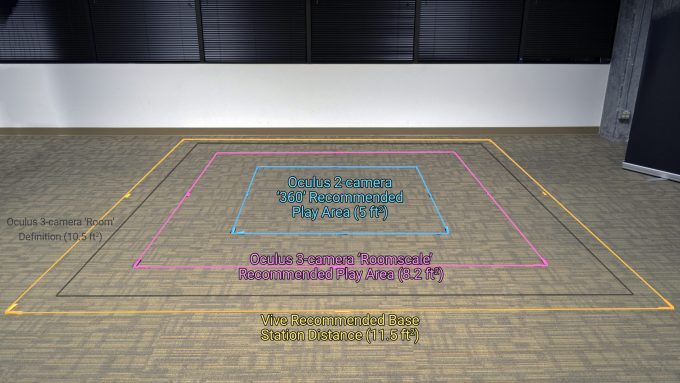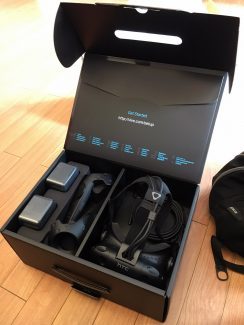Despite its primary competitor, Oculus, making a major price cut to the Rift & Touch earlier this year, HTC’s Vive headset still sits at a hearty $800. The company’s GM of VR, Daniel O’Brien, tells us why HTC hasn’t cut the cost of their headset in response.
Price Point
Speaking to Road to VR this week at E3 2017, O’Brien broached the topic of virtual reality’s rate of adoption since the launch of the Vive and Rift in 2016. He spoke of hyper-inflated analyst projections and eventually about the price of VR hardware which he acknowledged to still be acceptable only for the early-adopter segment. And while it was agreed that the price of VR will need to come down over time in order to grow the virtual reality market into the mainstream, O’Brien offered a justification for the Vive retaining its $800 price point even in the face a $200 cut to the Rift + Touch earlier this year.
Speaking to the system’s ability to more easily scale to room-sized play spaces than the Rift, he explained, “we haven’t dropped the core price of the Vive because we think it offers the best room-scale [experience], hands down.”
 Indeed, the Vive’s SteamVR Tracking tech requires two external sensors that only need wall power to offer tracking in a sizeable 11.5 x 11.5 ft area. The Rift on the other hand tracks just 5 x 5 ft with two sensors (in a 360 configuration), and requires that both sensors connect directly to the host PC, which can mean more challenging cable management. An additional sensor can be added to the Rift for $60 to bump the tracked area up to 8.2 x 8.2 ft, and a fourth sensor may be able to offer an even larger space, though some computers run into issues with available USB bandwidth when using that many sensors; Oculus’ official recommendation is that adding more than three sensors is likely to create more issues than it’s worth.
Indeed, the Vive’s SteamVR Tracking tech requires two external sensors that only need wall power to offer tracking in a sizeable 11.5 x 11.5 ft area. The Rift on the other hand tracks just 5 x 5 ft with two sensors (in a 360 configuration), and requires that both sensors connect directly to the host PC, which can mean more challenging cable management. An additional sensor can be added to the Rift for $60 to bump the tracked area up to 8.2 x 8.2 ft, and a fourth sensor may be able to offer an even larger space, though some computers run into issues with available USB bandwidth when using that many sensors; Oculus’ official recommendation is that adding more than three sensors is likely to create more issues than it’s worth.
Price Leader
 While Oculus has claimed on several occasions to be selling the Rift at-cost, HTC confirmed in 2016 that it was turning a profit on the sale of each headset.
While Oculus has claimed on several occasions to be selling the Rift at-cost, HTC confirmed in 2016 that it was turning a profit on the sale of each headset.
Earlier this year Oculus reduced the cost of the Rift and Touch by $100 each, cutting the total cost of the headset and controllers to $600 (or $660 if you add the third sensor for a more comparable room-scale tracking area).
O’Brien’s explanation of the HTC’s stance on the Vive’s cost suggests the company sees itself as the price-leader, able to command the present price point without significant impact from lower priced offerings.
Value-sensitive vs. Price-sensitive
 O’Brien elaborated further on HTC’s perspective on the Vive’s price, saying that there are certainly price-sensitive customers who are looking for the lowest cost option, but there are also ‘value-sensitive customers who are willing to pay more if they feel they are getting better value out of their purchase;’ the latter is where a large portion of VR early-adopters fall, he said.
O’Brien elaborated further on HTC’s perspective on the Vive’s price, saying that there are certainly price-sensitive customers who are looking for the lowest cost option, but there are also ‘value-sensitive customers who are willing to pay more if they feel they are getting better value out of their purchase;’ the latter is where a large portion of VR early-adopters fall, he said.
And while the Vive remains at an $800 price point, HTC has been making subtle improvements to the system, perhaps adding to the Value that O’Brien speaks of. We reportedly recently that the company had reduced the headset’s weight by 15%, and began offering tweaked SteamVR Tracking basestations and improved packaging that doubles as a carrying case. The biggest improvement so far, however, is surely the Vive Deluxe Audio Strap which is a $100 add-on.
The headset’s price remains unchanged since launch, but the company has also aimed to offer value in the form of bundles, O’Brien said.
HTC has always included a few bundled games with the headset’s purchase, and lately began offering a one-month trial to the company’s Viveport Subscription service for access to additional VR content. HTC has also offered limited time deals that see the headset bundled with additional games, GPUs, or VR Ready PCs, which can represent overall savings of a few hundred dollars, said O’Brien.
During the 2016 holiday season, the best Vive deal we spotted was a $100 discount on the headset and a $100 gift card when bought from the Microsoft Store. For the coming holiday 2017 season we hope to see even steeper discounts.







